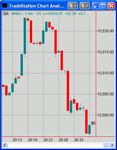The two recommended charting packages in the book are SierraCharts and Bigcharts so if Ozzie is getting different signals this could be due to the charting package he is using.
Even between the two used, one day last week there was a 40 point difference near the open between SC and BC, which one was right? I like to wait untill they agree.
Different data sources can give different values, also if your computer clock is slightly out so will the candles and therefore the indicator readings.
This is why I use Bigcharts in the daily results because it comes from a single source on the net and everyone should see the same thing.
. The book gently recommends a 20 point stop. So if it claims to win 75 times out of 100, with a suggested profit target of 6 points then do the math.
Sorry it does not claim to win 75 times out of 100, it is much higher, that is our guarrantee.
What has the stop got to do withe the reward/risk ratio? If I have a 600 point stop which never gets hit and a 6 point target is this a R/R of 100:1?
No, the correct way to calculate is to divide your average winner by your average loser, which is totally different. A 17 point stop from the initial high/low has not been hit this year.
This does not mean that there have not been losers there have but the average loss for the year so far is just 3 points. A totally different calculation.
It is a well known fact that when giving any system to a group of traders there will be various results, this has nothing to do with subjectivity.
It has been found that newcomers outperform the more experienced trader, why? Simply because they just follow the rules whereas the trader may hesitate or change things to what he already knows.
I only use half of the points possible in the move in the daily results which over the long term is my average.


